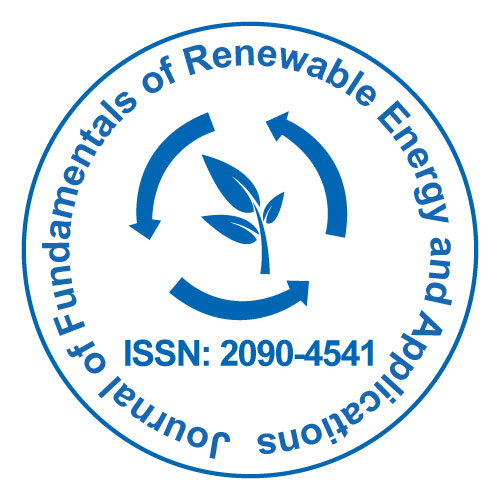
Journal of Fundamentals of Renewable Energy and Applications
Open Access
ISSN: 2090-4541

ISSN: 2090-4541
Ronak A Hassan and Mohammedamin Y Taha
University of Duhok, Iraq
Scientific Tracks Abstracts: J Fundam Renewable Energy Appl
Statement of the problem: The utilization of woody biomass in Duhok Governorate for supplying energy is an
important subject. Especially, now-a-days there are a lot of disputes around the fossil fuels and their insufficient
supply according to the increase of the inhabitance in addition to the unstable economic situations that limit itâ??s
acquiring. As well as their negative impact on the environment and the purpose of this study is to determine the
amount of lignin in the tested samples to find out the best source for biomass energy since it is correlated with the
heating value that is provided from their burning and hence prevent the over cutting of inefficient trees. Eventually,
the results of this study will investigate the regionâ??s capacity and the amount of biomass and fill some of the forest
information gaps that face foresters in Duhok Governorate.
Methodology & Theoretical Orientation: Depending on the DBH trees were divided into three classes. From each
tree, three types of samples were taken, wood, bark and branch. Their wet weight were recorded, oven dried, grinded,
and soxhlet was extracted. 72% H2SO4 were used to obtain Klason lignin then FTIR used to characterize the lignin.
Findings: The highest value of lignin is based on the size of trees from large to small trees. Whilst the bark as the type
of sample was from large tree of Pine gave a highest level of lignin.
Conclusion & Significance: The results implied that the bark from both studied species are the best source for
woody biomass and are highly significance (p< 0.01) in lignin percentage for both: classes and the types of samples.
Recommendations: Increasing the plantations of Pinus brutia and set a harvesting plan that will provide the
sustainability in the utilization. Raising the awareness about the need to preserve forests and prevent over-logging
of trees.
Recent Publications:
1. White R H (2007) Effect of lignin content and extractives on the higher heating value of wood. Wood and
Fiber Science 19(4):446-452.
2. Long H, Li X, Wang H and Jia J (2013) Biomass resources and their bioenergy potential estimation: A
review. Renewable and Sustainable Energy Reviews 26:344-352.
3. Goldemberg J and Coelho S T (2004) Renewable energy-traditional biomass vs. modern biomass. Energy
Policy 32(6):711-714.
4. Pokharel R, Grala R K, Grebner D L and Grado S C (2017) Factors affecting utilization of woody residues
for bioenergy production in the southern United States. Biomass and Bioenergy 105:278-287.
5. Dibdiakova J, Gjølsjø S and Wang L (2014) Solid biofuels from forest-Fuel specification and quality
assurance. Rapport fra skog og landskap.
Ronak A Hassan has her expertise in education in the fields of Biology and Science. Her interest in this research has established after her gain a high diploma in spatial planning in the subject of: air pollution caused by vehicle emissions, so she thought that an alternative and a renewable form of energy will be suitable for the region especially during this dispute era over fossil fuels. Woody biomass is one of these forms of energy that can be processed if sustainably utilized for generating energy and biofuels. But first, this requires several researches and investigations to estimate the regions capacity of biomass and their affordability.
E-mail: ronak4a@yahoo.com